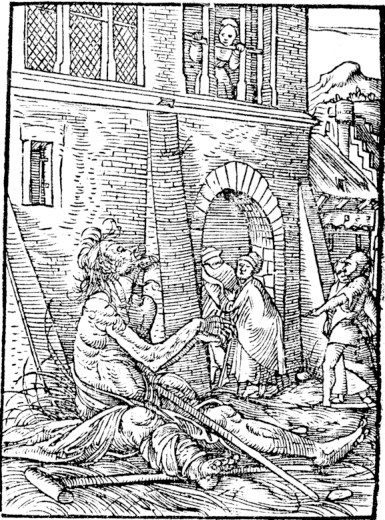
The Summer/Fall 2022 Issue of Christian Culture featured both Lucas Cranach the Elder’s 1529 painting, “Law and Grace,” as well as a woodcut imitation. You can easily see that the painting here, Hans Holbein the Younger’s oil painting, “An Allegory of the Old and New Testaments” (early 1530’s), is both the continuation and the perfection of this theme, which became prominent in the iconography of the Lutheran Reformation.
In content and composition, Holbein borrows heavily from Cranach, et. al. Reading down the left hand side of the painting, one encounters first the giving of the Law (Lex) to Moses. From this, the eye moves to Adam, Eve, and the serpent, as the Law reveals Sin (Peccatum), which then falls into Death (Mors). Since the painting is not strictly a display of Law and Gospel, but of the Old and New Testaments, the story of Moses and the serpent in the wilderness is also included on the left side, directly adjacent to the serpent who overcame by the tree of the Garden—and more on that shortly.
Reading down the right hand side, one finds first the gracious (Gratia) Annunciation to the Virgin; the eye then follows the path of light to the angel announcing the birth of Christ to the shepherds, who are placed at the right hand of the Crucified. Emerging from the shadows on the far right edge of the panel is Christ, the Lamb of God (Agnus Dei). All of this is consummated in the lower right, as Christ breaks forth from the tomb, granting us Our Victory (Victoria Nostra) over death.
The artist would also have us read his painting from left to right, placing the Annunciation/Gratia as the answer to the announcement of the Law/Lex, the Agnus Dei who takes away the sin of the world across from the coming of Sin/Peccatum, and the Resurrection/Victoria Nostra as the undoing of Death/Mors.
As similar as it is to its predecessors, the sophistication of this composition clearly surpasses that of Cranach, as Holbein’s figures move in more vivid light and shadow, and are placed perfectly on a realistic, three-dimensional landscape. There is no unused space, but neither are characters repetitively crowded into a simplistic series of panels. This more masterful arrangement brings out deeper connections between the Biblical stories. At the center of the painting, the congregation of Israel gathered around the bronze serpent (Mystery of Justification/Mysterium Iustificationis) is paired with the Christmas shepherds next to the crucifixion (Our Justification/Iustificatio Nostra), teaching that Christ and His Gospel are hidden, a mysterium, in the Old Testament and revealed in the New. This creates a new pathway for the eye, which is also the pathway of faith: from the serpent’s congregation at the tree, to the congregation of Israel at the serpent’s pole, to the congregation of shepherds and sheep anachronistically near the cross, to the congregation of disciples around the living Lamb of God.
Now, notice man (Homo), front and center, and then the tree that divides the two sides of the painting. The tree is dying through the revelation of the Law, and is coming to life with the revelation of the Gospel—and this tree is assimilated into Man in the painting, becoming almost an extension of his spine.
In the art and culture of the Renaissance, Man was well on his way to becoming, as Protagoras predicted, “the measure of all things” (Plato, Theaetetus), and one might be forgiven for seeing an anthropocentric worldview in Holbein’s choice to place Man at the center of his painting. Traditionally, this place was reserved for Christ or one of the saints, not Everyman.
What is centralized here, though, is not the apotheosis of man, but his degradation; he says “Wretched man that I am! Who will deliver me from this body of death?” (Rom. 7:24). And since it is not good that Man should be alone, the Prophet Isaiah (Esayas Propheta) steps out from the Old Testament to address Man directly, while John the Baptist (Ioannes Baptista) places his hand on Man from within the New Testament. “Behold,” says Isaiah, “the Virgin shall conceive and bear a Son” (Ecce Virgo concipiet et pariet Filium. Isa. 7) indicating the Mother of God in the upper right; and John, pointing at Christ, says, “Behold, the Lamb of God, who takes away the sin of the world” (Ecce Agnus ille Dei, qui tollit peccatum mundi. Io. 1). Under the influence of this proclamation, Man is turned away from sin and death, and is also no longer curved in upon himself. It is an uncomfortable posture, but so is the death of the old and the birth of the new.So Holbein has expanded Cranach’s visual formula to include you, the viewer, in the story, as if to say, “Quid rides? Mutato nomine de te fabula narratur!” (Horace, Satires: “What are you laughing at? Change the name and the story is told about you!”). The painting is not merely a didactic diagram of Law and Grace, but a lively representation of the daily death of your old Adam and the daily coming forth of the New Creature, under the power of the living Word. So may our lives in Christ always be, and so also every endeavor of Christian culture: not mere repristination, much less wooden imitation, but the perfection of the old, and also new creation. – J.H.



